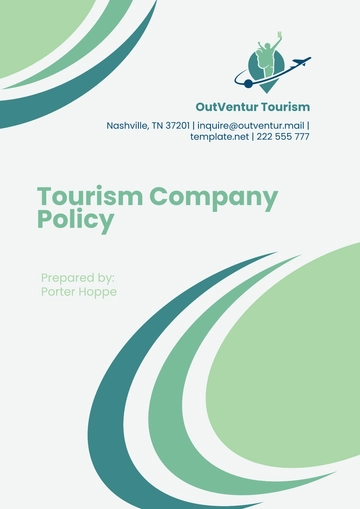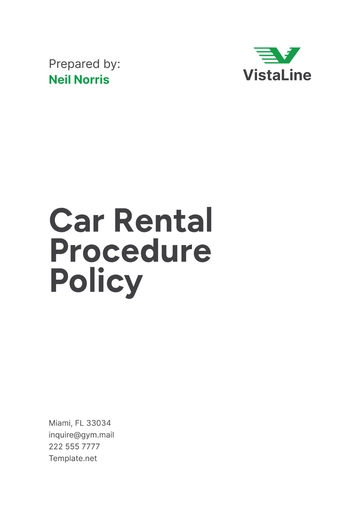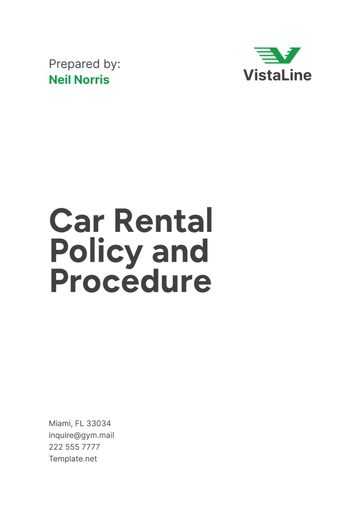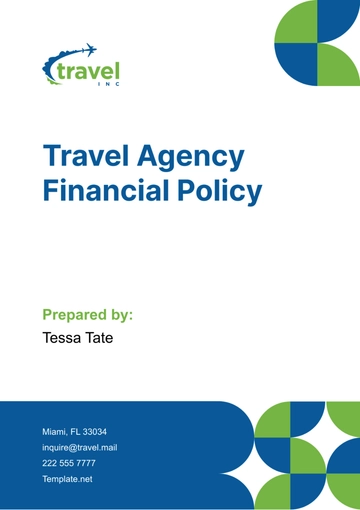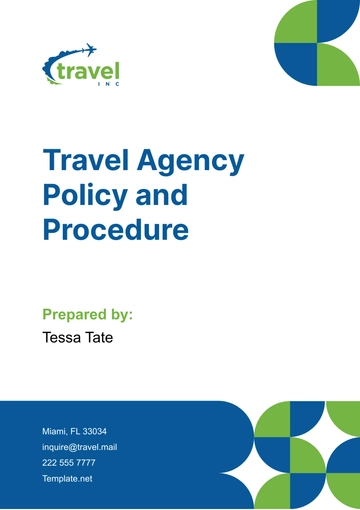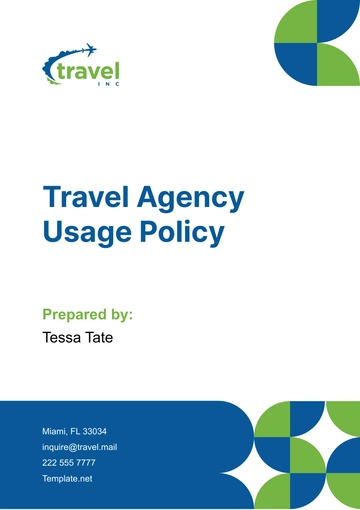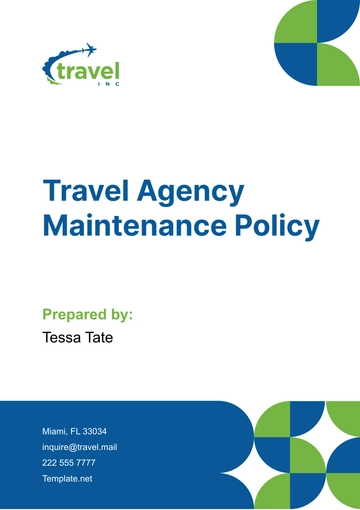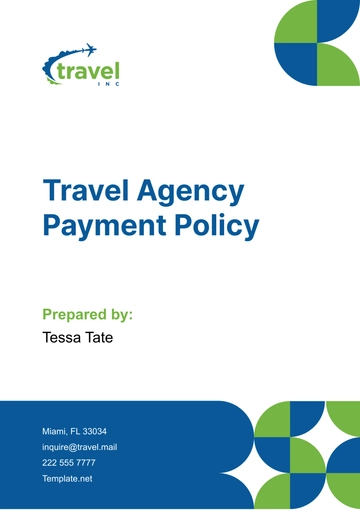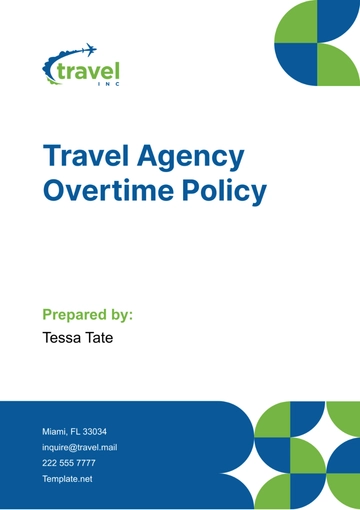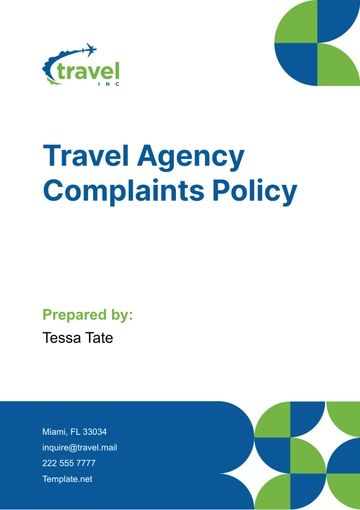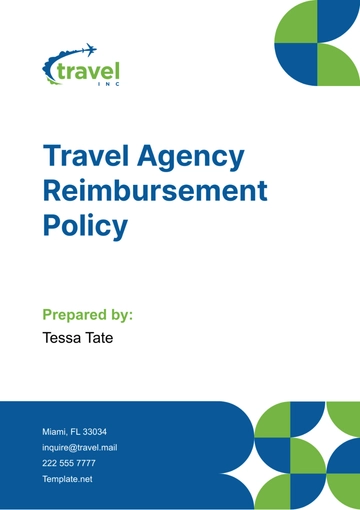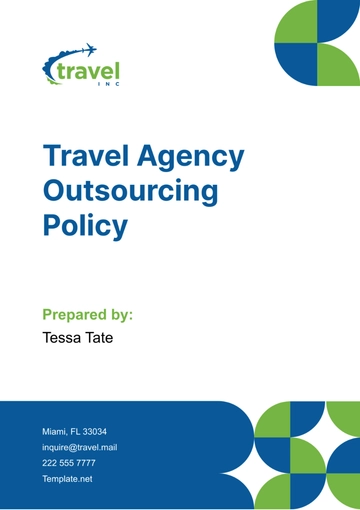Free Travel Agency Security Policy
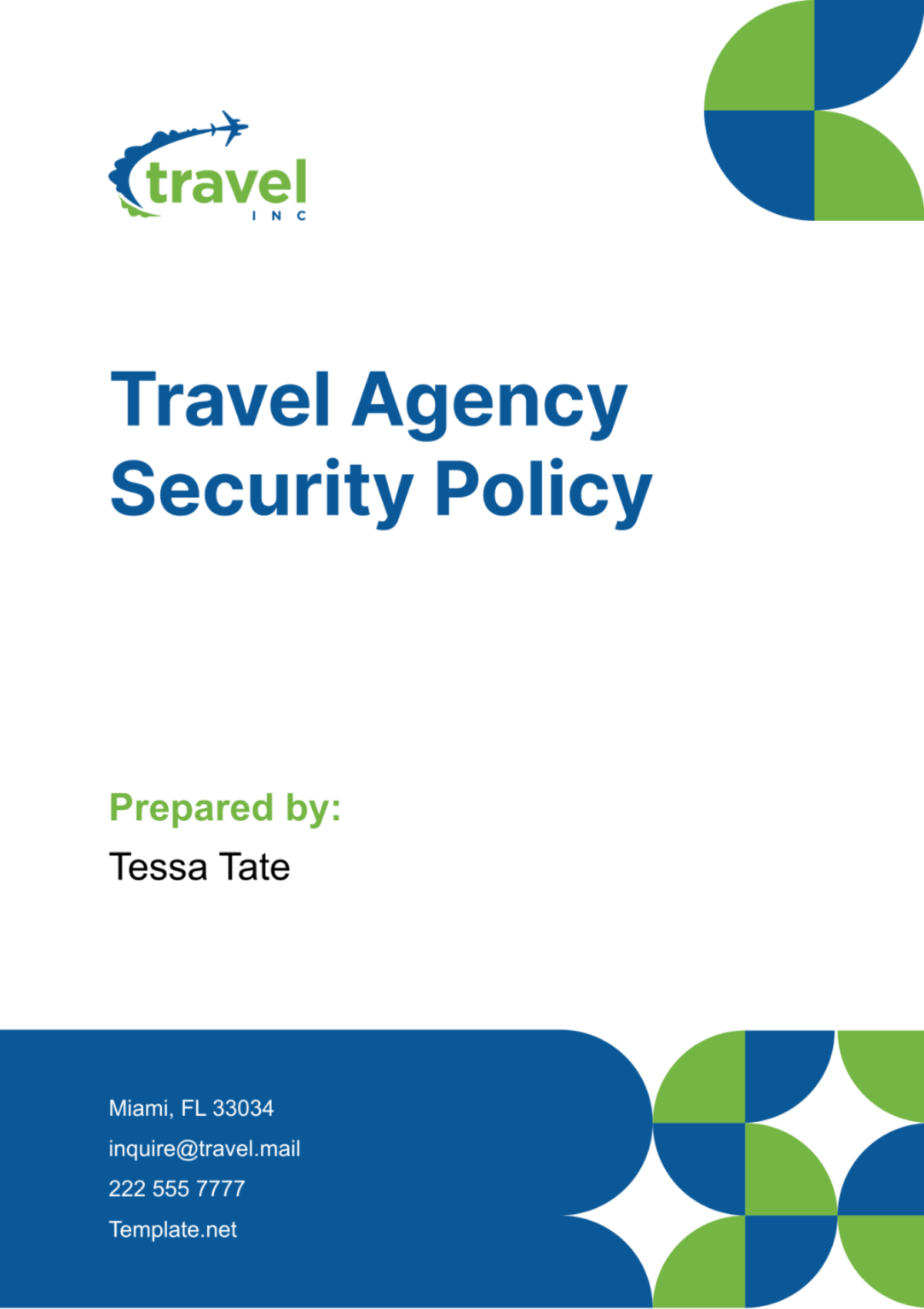
1. Policy Introduction
Purpose
The primary purpose of this Security Policy is to protect our organization's operational integrity, safeguard customer information, and ensure that our business complies with all regulatory requirements regarding data security. By setting these standards, [Your Company Name] aims to mitigate risks related to data theft, fraud, and other cyber threats.
Scope
This policy applies to all employees, contractors, and third-party service providers of [Your Company Name], encompassing all operational and administrative areas within the company.
Policy Enforcement
Employees found in violation of this policy may face disciplinary actions, including termination in severe cases. Continuous enforcement and updates will be managed by the Security Management Team to ensure the policy adapts to new threats and technological changes.
2. Data Protection
Customer Information Security
Action | Description |
|---|---|
Collect Only What is Necessary | Limit data collection to what is directly relevant and necessary to accomplish our business purpose. |
Secure Storage | Use encrypted databases to store sensitive customer information securely. |
Data Encryption
Type | Description |
|---|---|
At Rest | Encrypt all sensitive data stored on our servers using AES-256 encryption. |
In Transit | Use SSL/TLS to secure all data exchanges between clients and our servers. |
Data Access Controls
Level | Description |
|---|---|
Restricted Access | Only employees with a specific need will have access to sensitive data, controlled through role-based access controls. |
Monitoring and Logging | Every instance of access to sensitive data is meticulously logged and is subject to regular monitoring to ensure that there are no attempts to gain unauthorized access. |
Data Retention and Disposal
Procedure | Description |
|---|---|
Data Retention Policy | Maintain customer data for only as long as is legally required or necessary for the established business purpose. |
Secure Disposal | Use secure erasure methods such as cryptographic wiping or physical destruction of storage media to dispose of data no longer needed. |
3. Physical Security
Office Security
Feature | Description |
|---|---|
Security Systems | Install comprehensive alarm systems and CCTV coverage across all physical locations. |
Controlled Access | Implement a system of electronic keycard access to ensure that entry to the secured areas is restricted to authorized personnel only. |
Equipment Security
Device | Security Measure |
|---|---|
Computers | Ensure that it is safeguarded using password protection along with mechanisms that automatically lock the system. |
Mobile Devices | Ensure that devices are equipped with capabilities for remote wiping and are protected by strong encryption methods. |
Visitor Access
Process | Detail |
|---|---|
Sign-in | All individuals visiting are required to sign in upon arrival and must wear identification badges at all times during their visit. |
Escort | At all times while in secure areas, visitors are accompanied and escorted by an employee. |
4. Network Security
Firewalls and Intrusion Detection Systems
Implementation | Function |
|---|---|
Firewalls | Deploy enterprise-grade firewalls to monitor and control incoming and outgoing network traffic based on predetermined security rules. |
IDS | Use intrusion detection systems to actively monitor the network for malicious activities and policy violations. |
Secure Wi-Fi Use
Policy | Detail |
|---|---|
VPN | It is a requirement for all remote connections accessing our network to make use of virtual private networks (VPNs). |
Secure Configuration | Ensure that all Wi-Fi networks use WPA3 encryption for securing wireless communications. |
Endpoint Security
Requirement | Detail |
|---|---|
Antivirus Software | Ensure that all endpoints are equipped with antivirus software, which must be kept updated at all times. |
Regular Updates | Implement a policy to regularly apply patches and updates to all software in order to reduce and mitigate vulnerabilities. |
5. Employee Security Training
Awareness Programs
Frequency | Content |
|---|---|
Quarterly | Organize and conduct thorough security awareness training sessions in order to acquaint employees comprehensively with the most current security practices and emerging threats in the field. |
Phishing and Scams
Strategy | Detail |
|---|---|
Training Modules | Provide comprehensive and in-depth training that focuses on the identification of and response strategies to phishing attempts and various types of scams. |
Password Management
Policy | Implementation |
|---|---|
Strong Passwords | Mandate that passwords have a minimum length of twelve characters and include a combination of symbols, and numerals, as well as both uppercase and lowercase letters. |
Password Managers | Promote the practice of utilizing password management tools, which are designed to create and securely maintain complex passwords, thereby enhancing overall security. |
6. Incident Response and Management
Incident Reporting Procedures
Step | Action |
|---|---|
Identification | Employees are required to promptly report any security incidents that they suspect to the information technology department without delay. |
Documentation | Document all details of the incident to aid in investigation and remediation. |
Incident Response Team
Role | Responsibility |
|---|---|
Security Officer | Lead the response efforts and make high-level decisions. |
IT Personnel | Perform technical analysis and containment. |
Post-Incident Analysis
Task | Description |
|---|---|
Review | Analyze the incident to determine root causes and improve future security measures. |
Update Policies | Revise security policies and procedures based on lessons learned. |
7. Compliance and Legal Issues
Regulatory Compliance
Regulation | Compliance Strategy |
|---|---|
GDPR | Establish and enforce detailed protocols for safeguarding data that adhere to the stringent mandates of the General Data Protection Regulation (GDPR), which encompass principles such as data minimization and ensuring individuals' rights to have their personal data erased, commonly known as the right to be forgotten. |
CCPA | Ensure that all privacy notices are carefully drafted and that customer access to their data fully complies with the requirements set forth by the California Consumer Privacy Act (CCPA). |
Audit and Review
Frequency | Description |
|---|---|
Biannual | Carry out thorough security audits in order to guarantee compliance with this policy and to pinpoint any potential areas that may require enhancements. |
8. Third-Party Security
Vendor Management
Criterion | Detail |
|---|---|
Security Assessments | Before entering into contracts, it is crucial to conduct a thorough evaluation of third-party vendors to assess their security practices and ensure they meet the necessary standards. |
Service Level Agreements (SLAs)
Element | Detail |
|---|---|
Security Requirements | Ensure that all Service Level Agreements (SLAs) with vendors explicitly stipulate specific security standards that must be adhered to and clearly define the expected response times for addressing and resolving incidents. |
9. Continuous Improvement
At [Your Company Name], we understand that security is not a static field but one that evolves constantly as new threats emerge and technologies advance. Therefore, it is critical that our security practices, policies, and protocols evolve as well. To facilitate this, we have established a comprehensive system of feedback and policy updates that allows us to stay ahead of potential security issues.
We regularly solicit feedback through a variety of channels, including direct surveys, suggestion boxes, and exit interviews with employees. This feedback is invaluable as it provides insights from those directly interacting with our systems and policies daily. Additionally, we hold quarterly meetings where employees can discuss security challenges and propose improvements. This approach ensures that our security practices are not only top-down but are informed by the experiences and insights of our entire team.
Policy updates are scheduled on an annual basis but may be prompted more frequently by significant changes in the threat landscape, technological advancements, or following a security breach. Each update process begins with a thorough review of the current policy by our Security Management Team, who considers recent feedback, audit results, and emerging trends. Proposed changes are rigorously evaluated to ensure they enhance security without imposing unnecessary burdens on operations. Once approved, updates are communicated to all stakeholders through email, meetings, and training sessions, ensuring that the entire company understands and adheres to the new protocols.
10. Policy Review and Modification
The effectiveness of our Security Policy at [Your Company Name] is contingent upon its relevance to the current security landscape and regulatory environment. To ensure it remains pertinent and effective, we conduct a formal review of the policy annually. This review is spearheaded by the Security Management Team, who examine the policy in its entirety, assessing its success in mitigating security risks, compliance with legal and regulatory changes, and alignment with industry best practices.
Modifications to the policy may also be triggered by specific events such as security breaches, customer feedback, or new regulatory requirements. In these cases, the modification process involves a detailed analysis of what changes are needed and why. Proposals for modifications are meticulously drafted and then reviewed for their potential impact on business operations and security posture. Approval for changes is obtained from senior management to ensure that modifications have the necessary backing to be9. Continuous Improvement implemented effectively.
Once approved, modifications are documented formally in the policy document. Changes are then communicated to all relevant parties through a structured communication plan, which includes informational sessions, updated training programs, and revised documentation available on the company intranet. This ensures that every member of our organization, from top management to new hires, understands their roles and responsibilities under the new policy framework, ensuring seamless integration into daily operations.
- 100% Customizable, free editor
- Access 1 Million+ Templates, photo’s & graphics
- Download or share as a template
- Click and replace photos, graphics, text, backgrounds
- Resize, crop, AI write & more
- Access advanced editor
Secure your travel agency's operations with Template.net's Security Policy Template. This customizable and editable template integrates smoothly with the Ai Editor Tool, allowing you to develop comprehensive security protocols tailored to your needs. Strengthen your agency's defense mechanisms and ensure compliance with our expertly designed template, your gateway to enhanced security management.
You may also like
- HR Policy
- Restaurant Policy
- Company Policy
- Accounting Policies and Procedures
- Website Policy
- Privacy Policy
- Safety Policy
- School Policy
- IT and Software Policy
- Law Firm Policy
- Construction Policy
- Interior Design Policy
- Travel Agency Policy
- Education Academic Policy
- Security Policy
- Real Estate Policy
- Expense Policy
- Software Policy
